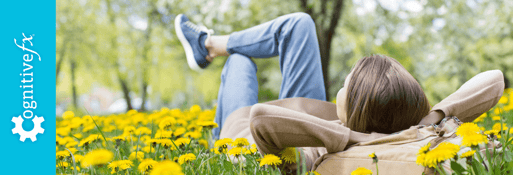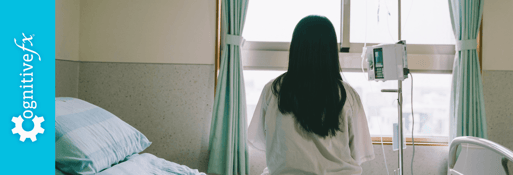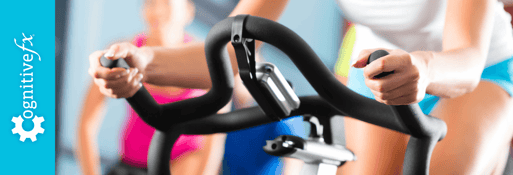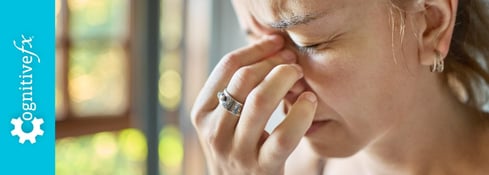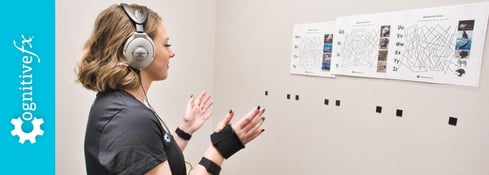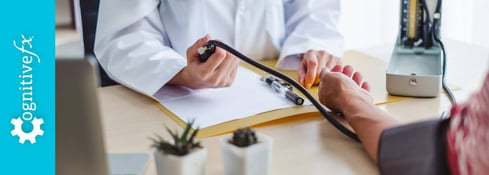Headaches. Dizziness. Brain fog. Constant fatigue. Feeling overwhelmed or like your emotions can’t stabilize. These and so many other symptoms can remain for months, or even years, after a concussion. If you feel like your recovery is excruciatingly slow, you’re not alone. Up to 30% of people who suffer a concussion experience persistent symptoms for months or years later.
If you’ve experienced concussion symptoms for more than three months after your injury, and you’ve ruled out other health conditions as being the primary symptom cause, you may have post-concussion syndrome (PCS). Also referred to as “persistent post-concussion symptoms,” this condition occurs when the brain and body do not recover from a mild traumatic brain injury (mTBI) within the expected time frame. The resulting symptoms might persist continuously or come and go in waves. Some patients also have symptoms that only surface weeks or months after the injury.
Diagnosis and treatment are critical for PCS because most patients do not recover without help. But finding the right place to get your PCS diagnosis and treatment can be a challenge. Most doctors don’t have the resources to assess and treat this condition in house. Often, they will offer medication to manage specific symptoms, but many post-concussion syndrome patients do not respond well to these medications.
The best option for post-concussion syndrome treatment is a rehabilitation clinic specializing in long-term symptoms. At Cognitive FX, we have state-of-the-art technology to determine exactly where the concussion is affecting your brain. And we can use that data to tailor your therapy exercises during one or more weeks of multidisciplinary treatment. Our rehabilitation program is designed to address the root cause of your symptoms rather than to mask individual symptoms.
The good news is that many patients with post-concussion syndrome go on to recover when properly treated. Our post about recovering from post-concussion syndrome includes stories from patients who made a significant recovery after treatment.
In this post, we explain:
If you are experiencing frustrating symptoms, but it has not yet been three months since your injury, consider visiting a local concussion clinic. Soon after a concussion, symptoms are easier to treat with physical, vestibular, and visual therapy, which you can sometimes find locally. We recommend Neural Effects concussion clinic in Provo, Utah if you live in the Utah Valley area.
If you live further away, see this state-by-state list of concussion clinics.
On average, our patients’ symptoms improve by 60% after just one week of treatment at our center specializing in neuroplasticity-based therapy. To see if you are eligible for treatment, sign up for a consultation.
Why Am I Experiencing a Slow Concussion Recovery?
.png?width=551&height=244&name=Slow%20Concussion%20Recovery%20(1).png)
For most patients, the expected concussion recovery time ranges from a few days to two weeks. These patients return to their normal, daily activities when they are symptom-free.
Unfortunately, for some patients, not all symptoms resolve within this time frame. Up to 30% of patients have lingering symptoms that can last months or even years. If you’re struggling with a slow recovery after your concussion, you may be wondering why.
The truth is that we don’t fully understand what triggers post-concussion syndrome (PCS) or why some patients develop PCS and others do not. Many mechanisms have been proposed as predictors of long-term symptoms — such as loss of consciousness at time of injury, memory loss, confusion, and so forth — but not all studies draw the same conclusions. But we do know most of the physiological causes of symptoms.
Symptoms of PCS are most commonly caused by the following:
- Neurovascular coupling dysfunction
- Dysfunction of the autonomic nervous system
- Vision problems
- Vestibular dysfunction
- Hormonal problems
- Altered breathing dynamics
Neurovascular Coupling (NVC) Dysfunction
.png?width=800&height=354&name=Slow%20Concussion%20Recovery%20(12).png)
The brain is a complex organ. Brain cells rely on an extensive network of blood vessels to bring them oxygen and nutrients when they need them. If your brain needs resources to perform a particular task, the neurons involved request what they need, and surrounding blood vessels deliver to the appropriate region. This dynamic relationship is called neurovascular coupling (NVC).
However, concussions trigger microcellular inflammation and swelling in the brain, often restricting blood flow from reaching injured areas. As a result, when your brain tries to perform a task — such as following a conversation or trying to remember something — it may struggle due to a lack of resources. The brain may attempt to use alternative neural pathways to complete the task, but this is less efficient and tires the brain more quickly.
Further reading: Why you can’t see damage from a concussion on a structural MRI
For the majority of people who suffer from a concussion, swelling and inflammation go down after a few days and the brain reverts back to using the most efficient pathways for any given process.
However, if the brain keeps using less efficient pathways to complete tasks even after the inflammation has resolved, patients continue to experience symptoms. The more your brain resorts to ineffective pathways, the more likely you are to experience a slow recovery. Poor NVC can result in many neuropsychological symptoms, such as poor short-term memory, headaches, feeling overwhelmed, post-concussion emotional changes, fatigue, and more.
Dysfunction of the Autonomic Nervous System (ANS)
The ANS controls many ‘behind the scenes’ bodily functions, such as blood pressure regulation, breathing rates, and heart rate. The two largest branches of the ANS are the sympathetic nervous system (SNS) and the parasympathetic nervous system (PNS). The SNS prepares the body for emergency situations by increasing blood pressure and breathing rates. It drives the fight-or-flight response. In contrast, the PNS slows heart rate, lowers blood pressure, and stimulates the digestive tract. This response is what we refer to as ‘rest and digest.’
Under normal circumstances, these two branches work together in harmony. They dynamically hand off control to each other as needed throughout the day. For example, the SNS may be in control if you’re stressed because you’re late for work, but then the PNS takes over when you’re relaxed watching TV in the evening.
However, in TBI patients, the SNS often becomes dominant even when there’s no need to react to a stressful situation. As a result, patients may experience many different symptoms, including irregular breathing, high blood pressure, neck pain, headaches, digestive issues, dizziness, sensitivity to light, and more.
.png?width=1405&height=1482&name=Slow%20Concussion%20Recovery%20(11).png)
Patients can develop ANS dysfunction — called dysautonomia — immediately after a concussion or in the months and years after the original injury, further delaying their recovery.
Further reading: Guide to Post-Concussion Autonomic Dysfunction (Dysautonomia)
Vision Problems
Vision problems are common after a traumatic brain injury and often prevail for a long period afterward if not treated properly.
Brain injuries can affect the communication between your brain and eyes, as well as disrupt neurovascular coupling in the areas of the brain that process visual information. As a consequence, PCS patients may experience a wide range of vision impairments, such as double vision, tired eyes, and problems with focusing and eye teaming (how the eyes work together).
Most visual problems after a concussion dissipate within a few weeks of the injury, but that’s not always the case. Vision therapy —sometimes called neuro-optometric rehabilitation — can be effective for patients who experience visual symptoms for longer than three months. Some patients experience notable recovery, some recover a bit and then plateau, and others don’t notice a benefit until they receive other therapies first.
Further reading: Vision problems after head injury
Vestibular Dysfunction
.png?width=552&height=461&name=Slow%20Concussion%20Recovery%20(10).png)
A slow recovery after head trauma can also be the consequence of vestibular problems. The vestibular system, which is located in the inner ear, helps your brain maintain balance and keep your vision stable when you move.
A TBI can disrupt the connection between your brain, vision, and vestibular system, making it more difficult for the brain to make sense of how you’re positioned relative to your surroundings. This leads to various symptoms such as headache, dizziness or vertigo, balance problems, spatial disorientation, and others.
Patients who develop long-term vestibular symptoms need vestibular rehabilitation designed to address their specific symptoms. Look for providers who can differentiate between different vestibular issues, such as a problem with ear crystals versus an integration issue between the vestibular system and the brain stem, autonomic nervous system, vision, etc.
Further reading: Why vestibular therapy helps concussion patients
Hormonal Dysfunction
.png?width=1744&height=720&name=Slow%20Concussion%20Recovery%20(13).png)
Brain injuries can also damage the hypothalamus and pituitary glands. These small structures, located at the undersurface of the brain, are responsible for controlling hormone levels in the body.
Damage to these areas can disrupt many different hormones, resulting in a variety of symptoms, including low blood pressure, weight gain, low libido, amenorrhea, heart palpitations, hair loss, fatigue, mood swings, headaches, and more.
Some of these symptoms overlap with expected short-term concussion symptoms. Many healthcare providers fail to diagnose hormonal issues promptly. This could be one of the reasons why you’re experiencing a slow recovery. Hormone imbalance often needs to be addressed with appropriate medication. Otherwise, associated symptoms will likely not improve.
Further reading: Hormone dysfunction following head injury
Altered Breathing Dynamics
.jpg?width=1000&height=450&name=Slow%20Concussion%20Recovery%20(8).jpg)
Breathing is an automatic function controlled by the brain and autonomic nervous system. After a concussion, the mechanisms responsible for regulating the levels of carbon dioxide (CO2) and oxygen (O2) in the bloodstream may be disrupted. Or, you may find that your post-concussion breathing dynamics have changed.
Many doctors do not know to look for this condition, but it can delay your recovery if not treated properly. Oxygen deficits and overabundance alike can lead to symptoms. Breathing issues may cause you to feel dizzy and lightheaded, have frequent headaches, or struggle with physical activity (such as jogging). Breathing exercises — an important part of the treatment we offer at Cognitive FX — go a long way to help with these symptoms and accelerate your recovery.
Further reading: Concussions can cause difficulty breathing
Do I Need Treatment to Deal With My Slow Recovery?
.jpg?width=1999&height=1333&name=Slow%20Concussion%20Recovery%20(5).jpg)
Seek treatment if at least one of the following is true:
- Your symptoms have not gone away after three months.
- You are experiencing new symptoms potentially caused by the concussion.
- Your symptoms are worsening.
- You need to return to work or school but haven’t been able to reach your previous activity level on your own.
After roughly three months, it becomes harder for your brain to go back to normal. Your brain may get "stuck" using inefficient neural pathways instead of returning to its pre-concussion state. And one-size-fits-all post-concussion interventions may not be enough for a full recovery.
At Cognitive FX, we believe that the best way to approach treatment is by knowing exactly how and where the concussion has affected your brain. This is why our patients go through a brain imaging scan called functional neurocognitive imaging (fNCI), which identifies which regions of the brain were affected by NVC dysfunction and whether it has altered the way they communicate with other regions.
In practical terms, fNCI is a type of functional MRI that assesses how blood flows throughout 56 regions of the brain while the patient performs a series of standardized cognitive tasks. From these results, we can infer healthy vs. dysfunctional brain function in those areas and develop a customized treatment plan.
Here’s an example of an fNCI scan result summary from a patient with pronounced NVC dysfunction:
.png?width=670&height=460&name=Slow%20Concussion%20Recovery%20(2).png)
Scores in the yellow or red zones indicate brain neural systems we will target specifically during the treatment program because they’re the ones in most need of rehabilitation.
In addition, we can evaluate which brain regions have healthy or unhealthy communication patterns with other regions.
.png?width=531&height=254&name=Slow%20Concussion%20Recovery%20(14).png)
For example, the scan above identifies many areas of the brain (marked in blue) that are underperforming, such as the thalamus (involved in filtering, arousal, sleep, and more) and the hippocampus (memory, learning, consolidation).This vital information helps our therapists decide on the best exercises for each patient.
The second reason we advise you to seek treatment is that symptoms triggered by ANS dysfunction, as well as vision and vestibular issues (as described above), may require more therapy to treat as weeks turn into months after your concussion.
To address this matter, in addition to the brain scan, we also evaluate all of our patients for any signs of ANS, vision, or vestibular problems to get a whole picture of how PCS has affected their bodies. That’s in addition to symptom reports and a physical and cognitive examination. Our therapists and doctors then bring together all the relevant information and design a custom-made treatment regimen according to the patient’s specific needs and abilities.
Want to discuss your symptoms with our team? Sign up for a consultation.
Persistent Concussion Treatment at Cognitive FX
.jpg?width=1999&height=1333&name=Slow%20Concussion%20Recovery%20(7).jpg)
Post-concussion rehabilitation at Cognitive FX involves a unique combination of exercise and therapy.
During our treatment program (EPIC treatment), all patients cycle through three stages: Prepare, Activate, and Recover. First, we prepare the brain for therapy. Then, we immerse the brain in a careful selection of therapy exercises. Finally, we provide recovery time before going through the process all over again.
Prepare
.jpg?width=1999&height=1333&name=Slow%20Concussion%20Recovery%20(9).jpg) Therapy sessions start with short bursts of aerobic exercise on a stationary bike or another exercise machine, followed by measured breathing. This combination encourages the SNS and PNS to work together in harmony, improves blood flow in the brain, and triggers the release of chemicals in the brain that boost the brain’s response to therapy. One of those chemicals is called brain-derived neurotrophic factor (BDNF), and it improves therapy outcomes in brain injury patients. This phenomenon is called the post-exercise cognitive boost (PECB). It’s a powerful way to reduce symptoms of a concussion in every stage of treatment.
Therapy sessions start with short bursts of aerobic exercise on a stationary bike or another exercise machine, followed by measured breathing. This combination encourages the SNS and PNS to work together in harmony, improves blood flow in the brain, and triggers the release of chemicals in the brain that boost the brain’s response to therapy. One of those chemicals is called brain-derived neurotrophic factor (BDNF), and it improves therapy outcomes in brain injury patients. This phenomenon is called the post-exercise cognitive boost (PECB). It’s a powerful way to reduce symptoms of a concussion in every stage of treatment.
Activate
.jpg?width=1999&height=1333&name=Slow%20Concussion%20Recovery%20(3).jpg)
After physical exercise, patients undergo a series of physical and cognitive therapies, including:
To further increase the impact on your brain, some of these therapies are combined. For example, our therapist may ask you to simultaneously balance on a Bosu board (to exercise your vestibular system) while tossing a football back and forth (to improve hand-eye coordination) and naming a city for each letter of the alphabet (to train word recall).
Another example is sensorimotor therapy, where you may have to clap and stomp to the beat of a metronome while completing a visual maze taped to the wall.
These concurrent exercises push multiple regions of your brain to activate at the same time.
Rest
.jpg?width=800&height=354&name=Slow%20Concussion%20Recovery%20(4).jpg)
Rest is an important component of therapy, and it’s more than just kicking back and relaxing until your next appointment. Some examples of how our patients spend time recovering include:
Brainwaves. Patients relax in a dark room listening to binaural beats. An app produces two close-but-not-the-same sound frequencies that the brain condenses into one single frequency, helping the brain relax in a manner similar to meditation.
Neuromuscular massage. Our physical therapists administer massage of the neck and shoulders. The aim is to relieve tension, improve circulation, and alleviate headache pain.
Mindfulness. Our therapists teach patients mindfulness techniques to help both body and brain rest.
At the end of treatment, patients undergo a second scan and then meet with a member of our team to go over the results. They receive a list of “homework” exercises, typically including a few aerobic exercises, cognitive activities, and ways to rest at home. Completing these exercises takes no more than one hour, five days a week, and will go a long way toward speeding up the healing process at home. As patients continue to recover and return to normal activities, they can decrease the time they spend on this homework while making sure to keep exercise as part of their daily routine.
Want to read about other concussion patients’ recovery stories? Here are five concussion recovery stories:
90% of our patients show symptom improvement after just one week at our clinic. To see if you are eligible for treatment, sign up for a consultation.

.jpg)
.png?width=551&height=244&name=Slow%20Concussion%20Recovery%20(1).png)
.png?width=800&height=354&name=Slow%20Concussion%20Recovery%20(12).png)
.png?width=1405&height=1482&name=Slow%20Concussion%20Recovery%20(11).png)
.png?width=552&height=461&name=Slow%20Concussion%20Recovery%20(10).png)
.png?width=1744&height=720&name=Slow%20Concussion%20Recovery%20(13).png)
.jpg?width=1000&height=450&name=Slow%20Concussion%20Recovery%20(8).jpg)
.jpg?width=1999&height=1333&name=Slow%20Concussion%20Recovery%20(5).jpg)
.png?width=670&height=460&name=Slow%20Concussion%20Recovery%20(2).png)
.png?width=531&height=254&name=Slow%20Concussion%20Recovery%20(14).png)
.jpg?width=1999&height=1333&name=Slow%20Concussion%20Recovery%20(7).jpg)
.jpg?width=1999&height=1333&name=Slow%20Concussion%20Recovery%20(9).jpg) Therapy sessions start with short bursts of aerobic exercise on a stationary bike or another exercise machine, followed by measured breathing. This combination encourages the SNS and PNS to work together in harmony, improves blood flow in the brain, and triggers the release of chemicals in the brain that boost the brain’s response to therapy. One of those chemicals is called brain-derived neurotrophic factor
Therapy sessions start with short bursts of aerobic exercise on a stationary bike or another exercise machine, followed by measured breathing. This combination encourages the SNS and PNS to work together in harmony, improves blood flow in the brain, and triggers the release of chemicals in the brain that boost the brain’s response to therapy. One of those chemicals is called brain-derived neurotrophic factor .jpg?width=1999&height=1333&name=Slow%20Concussion%20Recovery%20(3).jpg)
.jpg?width=800&height=354&name=Slow%20Concussion%20Recovery%20(4).jpg)

